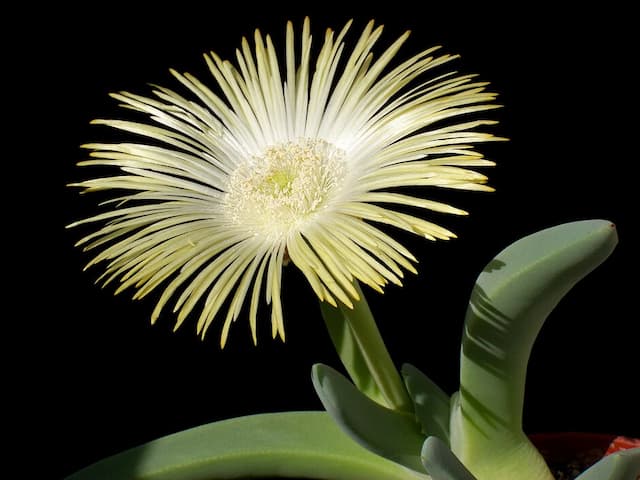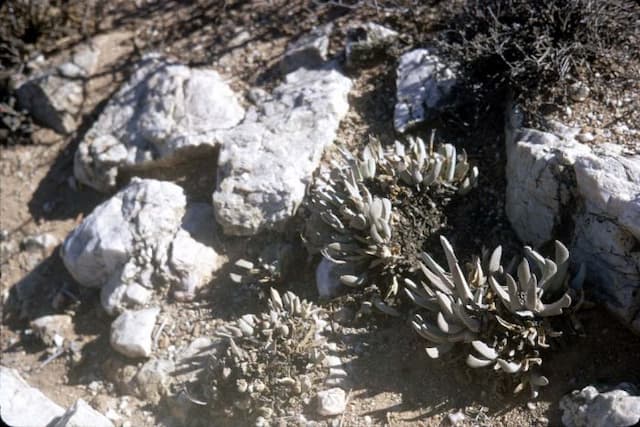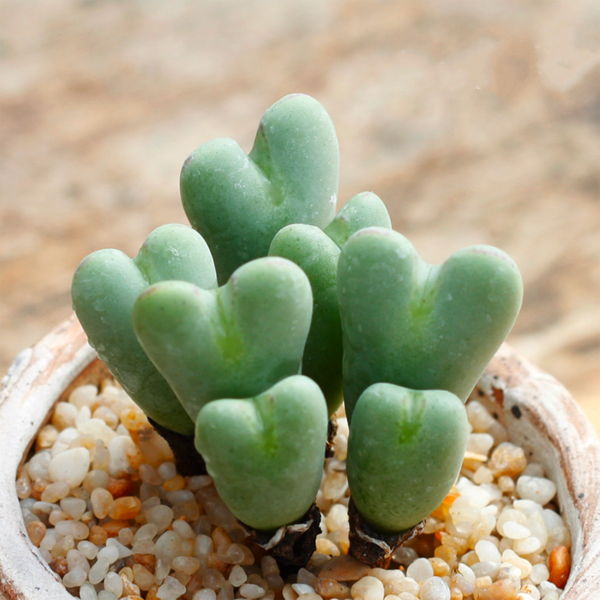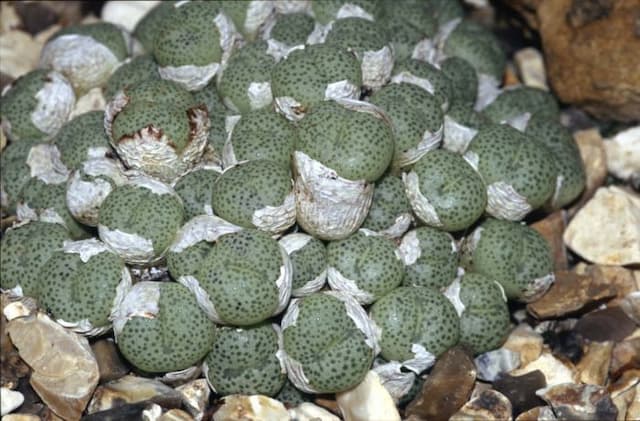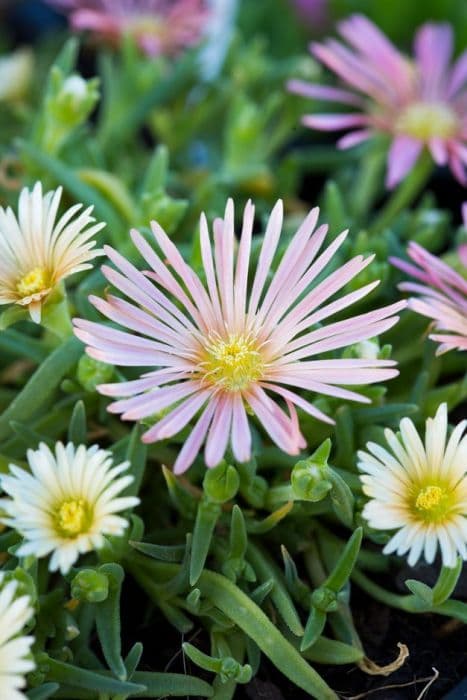Pink Vygie Lampranthus roseus

ABOUT
The plant known as the Pink Ice Plant is a vibrant and striking succulent that boasts fleshy, green leaves arranged in compact, opposite pairs that add a dimensional appearance. These leaves are often thick and shaped somewhat like small, plump pickles, exhibiting a glossy texture that makes them attractive even when the plant is not in bloom. The Pink Ice Plant is celebrated for its dazzling flowers, which provide a stark contrast to the greenery. The blossoms are pink and daisy-like in their form, with numerous slender petals radiating around a sunny-yellow center. These flowers are known for their propensity to open and close in response to the sunlight, often unfurling in the morning to soak up the sun's rays and closing in the late afternoon or on cloudy days. The overall impression of an in-bloom Pink Ice Plant is a brilliant carpet-like mat of color that adds brightness and texture to any space it inhabits.
About this plant
 Names
NamesSynonyms
Pink Vygie, Bitterroot, Rosea Ice Plant, Dewplant
Common names
Mesembryanthemum spectabile, Mesembryanthemum roseum
 Toxicity
ToxicityTo humans
The Lampranthus roseus, commonly known as the rosea ice plant, is not widely recognized as a poisonous plant to humans. However, as with many plants, individual sensitivity can vary. If ingested in large quantities, it could potentially cause mild stomach upset or an allergic reaction in some individuals. Signs of an allergic reaction may include itching, redness, or discomfort in the mouth or throat. If any parts of the plant are ingested and symptoms occur, medical attention should be sought.
To pets
The Lampranthus roseus, also known as the rosea ice plant to pet owners, is not known to be toxic to pets like dogs and cats. While it may not be specifically listed as poisonous, it is still advisable to prevent pets from ingesting this or any ornamental plant. Eating non-food plants can potentially result in gastrointestinal upset for pets, possibly causing symptoms such as vomiting or diarrhea. If a pet ingests the plant and exhibits signs of distress, it's recommended to contact a veterinarian.
 Characteristics
CharacteristicsLife cycle
Perennials
Foliage type
Evergreen
Color of leaves
Green
Flower color
Pink
Height
1 feet (0.3 meters)
Spread
2 feet (0.6 meters)
Plant type
Succulent
Hardiness zones
9
Native area
South Africa
Benefits
 General Benefits
General Benefits- Low Maintenance: Highly adaptable and requires minimal care once established; excellent for gardeners looking for low-maintenance plants.
- Drought Tolerant: Naturally resistant to dry conditions and can survive with infrequent watering, making it perfect for xeriscaping and water-wise gardens.
- Ground Cover: Spreads effectively to cover ground, suppress weeds, and prevent soil erosion in gardens and landscapes.
- Attracts Pollinators: Bright flowers attract bees, butterflies, and other pollinators, aiding in the pollination of nearby plants.
- Decorative: Offers vibrant pink blooms that add a splash of color to rock gardens, borders, and containers.
- Fast Growing: Rapid growth rate allows for quick establishment and filling in of garden spaces.
- Rock Garden Suitability: Particularly well-suited to rock gardens due to its ability to thrive in well-draining, gritty soil.
- Seasonal Interest: Provides a burst of color typically in the spring and summer seasons, enhancing the seasonal appeal of gardens.
 Medical Properties
Medical PropertiesThis plant is not used for medical purposes.
 Air-purifying Qualities
Air-purifying QualitiesThis plant is not specifically known for air purifying qualities.
 Other Uses
Other Uses- Lampranthus roseus, commonly known as "ice plant," can be used as a natural dye; the pinkish-purple flowers are known to yield color when used in fabric dyeing processes.
- The succulent leaves of the ice plant could be employed in the creation of a moisture-retentive gardening mulch, helping to conserve water usage.
- The fleshy texture of ice plant leaves might be useful as a low-grade, natural abrasive for cleaning delicate surfaces when mild abrasion is needed.
- When dried and crushed, the flowers and leaves may be used as a component in potpourri mixtures, contributing a subtle fragrance and color.
- The ice plant can be used as a natural ground cover, preventing soil erosion on slopes due to its spreading habit and dense mat-forming ability.
- Decoratively, the ice plant can be employed in living walls and vertical gardens, owing to its minimal soil and water requirements.
- In culinary presentations, the ice plant's vivid flowers can be used as an edible garnish, although consumption should be limited due to their high water content and potential laxative effects.
- The plant’s ability to thrive in harsh conditions makes it an ideal candidate for use in xeriscaping, a landscaping method that reduces or eliminates the need for irrigation.
- The ice plant's sprawling nature could be creatively used to create living sculptures or topiaries with the appropriate supporting structures.
- The striking flowers of the ice plant may serve as an inspiration for artists and designers, being utilized as a model for patterns or designs in various forms of artwork or textiles.
Interesting Facts
 Feng Shui
Feng ShuiThe Ice Plant is not used in Feng Shui practice.
 Zodiac Sign Compitability
Zodiac Sign CompitabilityThe Ice Plant is not used in astrology practice.
 Plant Symbolism
Plant Symbolism- Resilience: The Ice Plant, also known as Lampranthus roseus, is incredibly resilient and can thrive in harsh, dry environments. It symbolizes the ability to endure challenging conditions and to survive against the odds.
- Beauty in Adversity: Despite growing in arid conditions, the Ice Plant produces vibrant, colorful flowers, representing the beauty that can be found even in tough circumstances.
- Vitality: Ice Plants are hardy and full of life, often blooming profusely. They represent vivacity and a strong life force.
- Adaptability: The plant's ability to adapt to less than ideal environments signifies flexibility and the capacity to adjust to new situations.
 Water
WaterFor the Pink Ice Plant, it's essential to allow the soil to dry out completely between waterings as they are drought-tolerant and succulent in nature. Typically, watering once every two weeks should suffice. During the active growing season in spring and summer, you may need to water more frequently, providing about one to two gallons depending on the size of the plant and the dryness of the soil. Reduce the frequency of watering in fall and winter to once a month or less. Always check the top inch of soil for dryness before watering and adjust your schedule accordingly to avoid overwatering, which can lead to root rot.
 Light
LightPink Ice Plants flourish in full sunlight and require at least six hours of direct sunlight daily. The best spot for these vibrant plants is a south-facing location where they can enjoy maximum light exposure. If you're growing Pink Ice Plants indoors, place them near a sunny window. Limited exposure to light may cause the plant to become leggy and produce fewer flowers, so ensure they receive plenty of sunshine.
 Temperature
TemperatureThe Pink Ice Plant thrives in warm environments and prefers temperatures between 40 and 80 degrees Fahrenheit. They can survive in temperatures as low as 30 degrees Fahrenheit for short periods but are not frost-hardy. Keeping the plant in an area that doesn't drop below 40 degrees Fahrenheit during cold months will help prevent damage. Ideal growing conditions for the Pink Ice Plant are warm and do not fluctuate dramatically.
 Pruning
PruningPrune Pink Ice Plants to remove dead or damaged growth and to shape the plant, which encourages a bushier and more attractive appearance. The best time to prune is in early spring before new growth begins. Pruning can be done once a year or as needed if you notice any damaged stems. Make clean cuts near the base of the unwanted stems, and remember to use clean, sharp pruning tools to avoid damaging the plant.
 Cleaning
CleaningAs needed
 Soil
SoilThe best soil mix for the Pink Ice Plant is a well-draining cactus or succulent mix, amended with coarse sand or pumice to increase porosity. The ideal pH range for this plant is between 6.0 and 7.5, slightly acidic to neutral.
 Repotting
RepottingPink Ice Plant should be repotted every two to three years, or when it outgrows its current container, to refresh the soil and provide room for growth.
 Humidity & Misting
Humidity & MistingPink Ice Plant prefers dry air and is tolerant of low humidity levels, making it suitable for arid and semi-arid climates.
 Suitable locations
Suitable locationsIndoor
Place Pink Ice Plant in bright light indoors for healthy growth.
Outdoor
Plant in full sun, well-draining soil; water infrequently.
Hardiness zone
9-11 USDA.
 Life cycle
Life cycleLampranthus roseus, commonly known as the pink vygie, starts its life cycle as a seed, which, when sown in well-drained soil and with adequate warmth, germinates to produce small, succulent seedlings. As these seedlings mature, they develop fleshy leaves and a sprawling stem that can take root at nodes in contact with the soil, establishing the plant firmly in the ground. The growth phase continues with the plant forming a dense mat of succulent foliage and, typically in spring to summer, it reaches the flowering stage where it produces vivid pink flowers that open in sunlight. After pollination, which is often aided by insects attracted to the flowers, the plant sets seed contained within a capsule that dries and opens to release seeds for the next generation. The adult plant will persist and continue to grow and bloom in subsequent seasons, being a perennial, it will go through the flowering and seeding cycle annually. Over time, individual plants can spread and create a ground cover, living for several years under appropriate conditions with some species of Lampranthus able to live for a decade or more.
 Propogation
PropogationPropogation time
Spring-Early Summer
The most popular method for propagating the ice plant, Lampranthus roseus, is via stem cuttings. The ideal time to take cuttings is during the warmer months of spring through early summer, when the plant is actively growing. For propagation, one should select healthy, non-flowering stems and cut a 3 to 5 inch (approximately 7.5 to 12.5 cm) length. The cut end should be allowed to dry and callous over a few days to prevent rot. The calloused cutting can then be planted in a well-draining cactus or succulent potting mix and kept in a warm place with indirect sunlight. Roots typically develop within a few weeks, after which the new ice plant can be gradually acclimated to more sunlight and less frequent watering.
